Lofty Goals: How to Finish an Attic
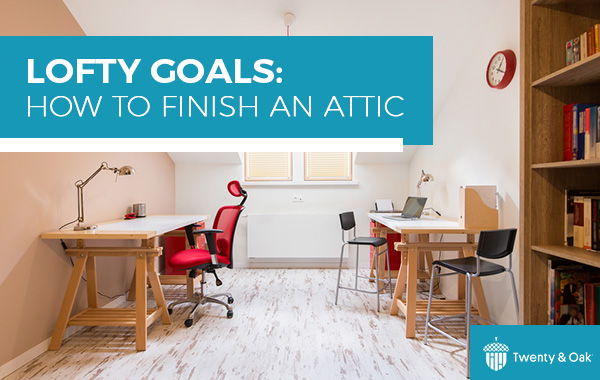
Attic spaces are often overlooked when it comes to renovations and home additions. It’s thought of as the place to store seasonal decor, boxes of old photos and hand-me-down sentimental items. In fact, most homeowners would rather remodel a basement before their attic.
But while it may seem intimidating and costly, remodeling an attic can provide a perch-like sanctuary and increase the value of your home.
Let’s take a look at how to finish an attic, as well as some of the considerations for remodeling an attic space to be a safe place for a child’s playroom, extra guestroom or even a home office or artist studio.
Considerations
From building codes to noise reduction, there are many structural adjustments to take into account.
Consider how your attic will be used. Is it intended as an extra play space or game room where the kids can escape? Is it for an extra bedroom suite for overnight guests? Or do you intend it to be a home office studio?
These questions can help determine the extent you wish to build out and finish your attic.
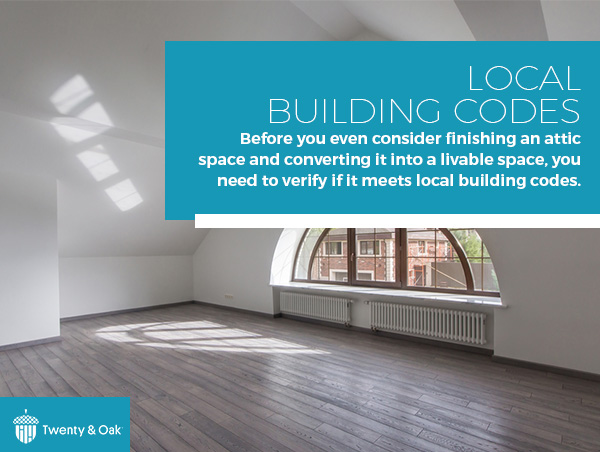
Local Building Codes
Before you even consider finishing an attic space and converting it into a livable space, you need to verify if it meets local building codes. Here are a few standard requirements to check first.
If you plan to make your attic space livable, it needs to meet the typical seven-foot ceiling height or clearance in a minimum of a seven-foot wide space–after finishes are installed! Many attic spaces meet this requirement, but if yours doesn’t, consider adding a dormer to extend the area into a minimum 70 square feet. Alternatively, you could raise the roof, but that can significantly increase the project’s budget.
Additionally, a pull-down ladder will need to be converted into a permanent, full-size staircase. However, doing so will also require a wider landing to rest and turn furniture that is desired in your new attic space.
Two means of egress are required in some local counties or states, allowing emergency evacuation. This can be an extra accessible window in addition to the added staircase.
Structural Integrity
Even if your attic meets building code requirements, it’s smart to hire a professional to take a look at the structural changes you wish to make.
Adding walls, flooring, furniture and people can add more weight than seasonal decor or that heirloom silverware set. Professionals can come in and assess the attic, offering advice on joist modifications and bump-outs.
In addition, this added weight above needs a sound structure below. A structural analysis can also determine if you need a load-bearing wall to support your newly finished attic space.
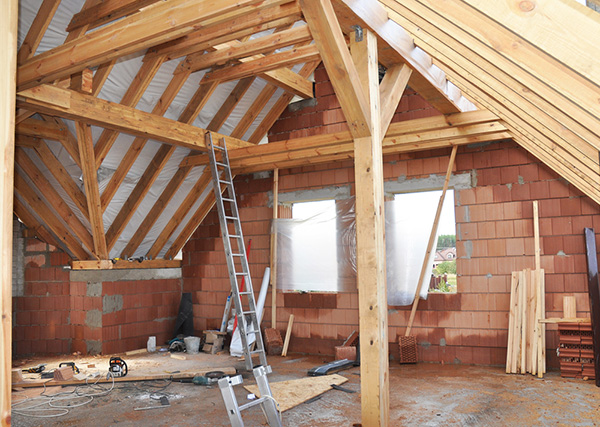
Rafters and Trusses
Your attic space will either have rafters or trusses to support your roof and load-bearing walls. Rafters are a more traditional stick framing method, but trusses are used more frequently, as they offer better roof support.
Unlike rafters, trusses are difficult to modify for attic conversions, as they contain more chords and webs that are meant to support the roof structure and reduce load-bearing walls on lower floors. With open concept floor plans becoming increasingly popular, so have trusses, and there’s a solid chance your attic has them. However, because you would be adding more weight to the attic, and potentially making changes to the trusses themselves, this can create a real safety hazard and is highly unadvised.
Rafters, however, are more friendly to a finished attic. They offer a more open space to allow for that seven-foot minimum head clearance. And they also offer a more structural sound attic, taking some of the weight off any lower load-bearing walls.
Joist Size and Spacing
Floor joists play a major role in keeping activity levels quiet. And hardier joists can withstand the weight of an occupied attic full of kids or heavy furniture.
For an attic to be structurally sound and able to transition into a habitable space, you need 2x10 or 2x12 joists. Most homes with a walk-up attic will have these larger joists. Smaller 2x6 and 2x8 joists are not safe for supporting furniture and people for a livable attic space. However, larger joists may not be safe either. In some homes, the attic joists were only meant to support the ceiling below and lack a secure structure to install anything more than fiberglass batting.
If you do have 2x6 or 2x8 joists, you still have the option to reinforce with bridging, sister joists and I-joists. This can boost the structural integrity and offer strength in the attic’s load-bearing floor. This is another reason to hire a professional contractor to take a look at the structural integrity of your home and attic space.
Next to your attic joist’s size, the joist’s spacing is important as well, especially in terms of flooring finishes and materials. To be able to install flooring, an attic’s standard joist spacing should be 16 inches on center (OC), meaning the measurement is taken from the center of each joist, not from edge to edge.
If you have an attic with joists measuring over 16 inches or reaching 24 inches OC, this is not ideal for the installation of flooring or converting your attic into a livable space. However, if you hire a contractor, they can offer advice on how to increase the structural support to get it there.
Heating, Air Conditioning and Ventilation
To make an attic space livable, it will need basic heating, air conditioning and ventilation.
If an attic already has ductwork to connect with an existing heating and air conditioning system, you can easily bridge and tack on the attic space. However, if it does not, you’ll need to hire a professional contractor to determine if it can be done.
A contractor can determine if existing ductwork can be extended to reach the attic and also if your current HVAC system can ultimately take on and support this extra attic space. Contractors can also determine if there are rafter vents, which are needed to maintain airflow and keep the roof cool as you crank up the heat.
If you lack ductwork or HVAC is simply out of your budget, there are still other options. You can instead install electric baseboard heaters, which do not require ductwork or a connection to your central heating. Another option is a mini-split that offers a heating and cooling system that allows temperature control only in the attic space.
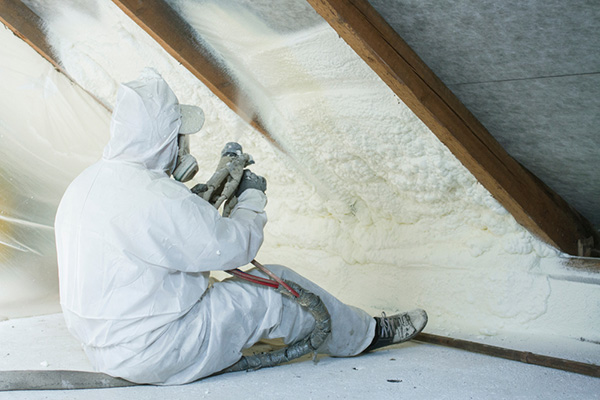
Use Spray Foam Insulation
If you need to dampen the noise levels, the bays between the joists will need insulation. As opposed to the low-density, fiberglass batting insulation you may already have, opt for the denser spray foam insulation instead. While it’s a bit more costly, it will create a tighter lining that will keep heat from escaping and allow for more overhead clearance.
Plywood Flooring Base
What you plan to use the attic space for may depend on the plywood sheet base you put down. If you only need the attic space for boxes of holiday decorations and to preserve nostalgic memorabilia, you can get away with thinner plywood. But if you plan to convert the attic space into a full bedroom or child’s play area, you need thicker ¾-inch plywood sheets to withstand the weight of large furniture items and people.
You should also consider the thickness of plywood when it comes to your joist spacing. If you have joists spaced at 16 inches apart, a thinner ½-inch plywood sheet is adequate. However, if joists are spaced 24 inches apart, a thinner ½-inch plywood sheet will flex and may even cause damage to attic flooring and the ceiling of the room below. With 24-inch joist spacing, it’s best to go with thicker ¾-inch plywood sheets.
Best Flooring for a Converted Attic
When finishing a loft or attic space in your home, you may assume all flooring options are available and on the table. However, there’s much more to consider due to this unique conversion.
Let’s take a look at some of the best flooring and each of their advantages.
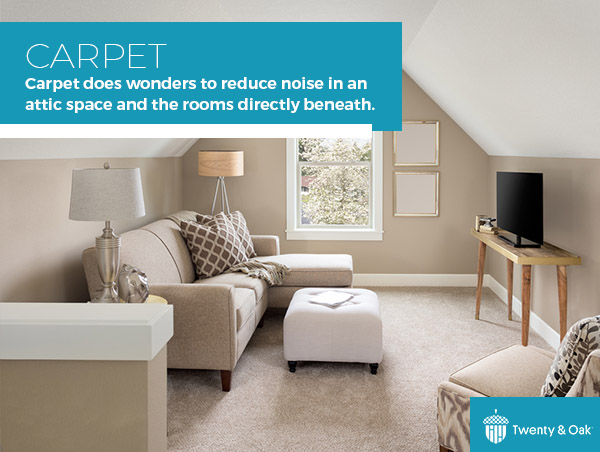
Carpet
Carpet does wonders to reduce noise in an attic space and the rooms directly beneath. This can be wall-to-wall carpet or carpet tiles. It can also offer a soft and comfortable floor for a child to play on.
However, carpet does have a few disadvantages–one of which is the cleanliness factor and ability to collect dirt. Carpet can also be difficult to replace should your attic find itself with a leaky roof.
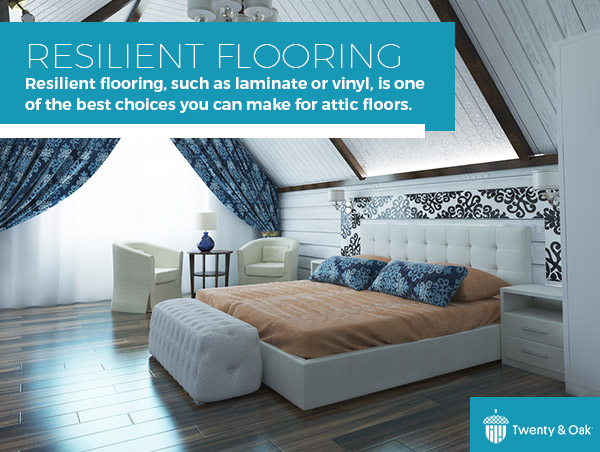
Resilient Flooring
Resilient flooring, such as laminate or vinyl, is one of the best choices you can make for attic floors. This type of flooring can soften the sounds when installed over an underlayment. And it’s also relatively thin, which means it is perfect if your attic’s height is barely meeting building code of seven-foot clearance. They’re also quite easy to maintain and incredibly self-healing and water-resistant should you wish to turn your attic space into, say, an artist studio.
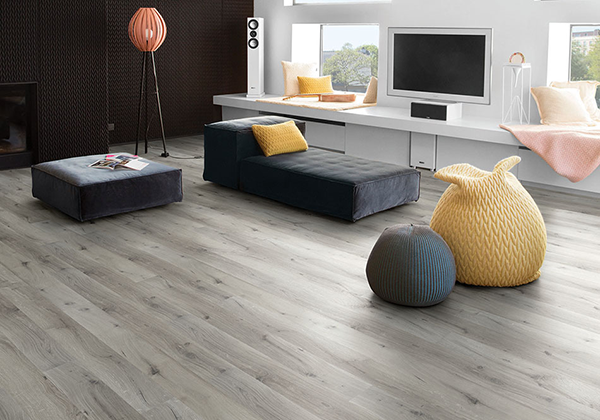
Beauflor Hydrana Gyant Light Grey
Laminate flooring is a fantastic flooring for a loft or attic space. It is quite easy to maintain and can look just like hardwood floors. It’s also budget-friendly, saving you dollars on your overall attic renovation, and water-resistant for accidental spills. Check out more reasons why laminate floors may be the best choice for you.
For attic spaces, we recommend a light and cheerful laminate flooring, such as Beauflor’s Hydrana collection. This collection also offers a locking system and attached padding for easy installation.
Vinyl sheet flooring is another type of resilient flooring best suited for attic spaces. No longer a dated ’70s look, today it comes in many modern styles. It offers high performance and resembles a variety of woodgrains, stones, and tiles–all in seamless patterns.
Because vinyl sheet flooring has progressed over the years, Twenty & Oak now offers a range of attractive options. Beauflor offers more than five unique and trendy vinyl sheet collections to consider for your attic remodel.
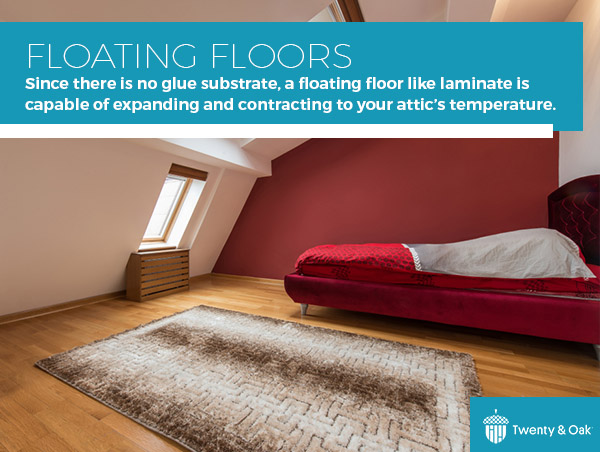
Floating Floors
Floating floors can be several different materials, from laminate to luxury vinyl floorings (LVF) such as planks or tiles. Since there is no glue substrate, a floating floor like laminate is capable of expanding and contracting to your attic’s temperature. This can come in quite handy if your attic is not occupied frequently and uses a separate HVAC system.
Unlike laminate, luxury vinyl flooring can be glued down. But it can also act as a floating floor with its engineered tongue and groove locking method, which is relatively easy and fast to install.
Both laminate and luxury vinyl flooringoffer excellent sound barriers between the attic and rooms beneath–but if it’s installed over padding, it will soften noise even more.
Floating floors also come in a number of styles such as laminate, vinyl, bamboo and hardwood. And as resilient flooring, laminate and vinyl provide the previously mentioned maintenance-free characteristics.
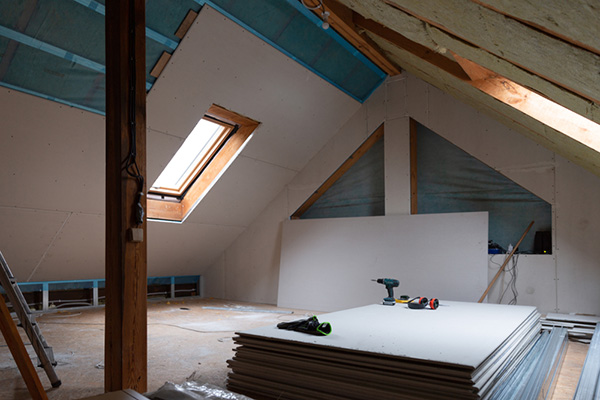
Before You Decide to Finish Your Attic
Before you finish your attic, it’s crucial to obtain all necessary permits and to invite structural engineers and licensed contractors to get a professional opinion. While converting an attic space seems straightforward–as if all you need to do is put up some walls and playboard to support a rug–there’s much more involved. When converting an attic space, safety and security are key.
Also, remember to pull a permit. Otherwise, what’s initially thought to be an upgrade to improve the value of your home could become a nightmare that comes back to haunt you. Should you go to sell your home, this permit is necessary, as is the adherence to local building regulations and codes. Without a permit, it could even reduce your home’s value.
As you convert your empty attic into a livable space where the kids can play or a quiet retreat to work, consider the best flooring option for your lifestyle.